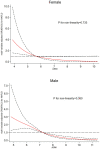Gender difference in association between low muscle mass and risk of non-alcoholic fatty liver disease among Chinese adults with visceral obesity
- PMID: 36713086
- PMCID: PMC9880268
- DOI: 10.3389/fnut.2023.1026054
Gender difference in association between low muscle mass and risk of non-alcoholic fatty liver disease among Chinese adults with visceral obesity
Abstract
Background and aims: Although the association between low muscle mass and the risk of non-alcoholic fatty liver disease is well-known, it has not been explored in viscerally obese populations by gender. Besides, whether low muscle mass still increases the NAFLD risk in subjects with visceral obesity, independent of obesity, is still unknown. The aim of this study was to explore the gender-specific association between low muscle mass and the risk of non-alcoholic fatty liver disease (NAFLD) in subjects with visceral obesity.
Methods: Overall, 1,114 participants aged 19-89 years were recruited in this retrospective study. Liver disease was diagnosed by hepatic ultrasound. Skeletal muscle mass was estimated by bioimpedance analysis and defined by the appendicular skeletal muscle index (ASMI). Gender-specific differences in the ASMI value were compared between NAFLD and control groups. Restricted cubic spline and multivariate logistic regression were performed to analyze the association (stratified by gender and age) between the ASMI and the risk of NAFLD, respectively.
Results: Middle-aged females (40-60 years) and males (of any age) with NAFLD had a significantly lower ASMI compared with controls (P-value < 0.05). An inverse linear association was found between the ASMI and risk of NAFLD (all P fornon-linearity > 0.05). Lower quartiles of the ASMI conferred independent risk of NAFLD compared to higher quartiles (all P for trend < 0.001). Low muscle mass conferred a higher risk of NAFLD in middle-aged females (adjusted odds ratio = 2.43, 95% confidence interval: 1.19-4.95) and males [18-39 years: 3.76 (1.79-7.91); 40-60 years: 4.50 (2.16-9.39); and >60 years: 4.10 (1.13-14.84)]. Besides, Low muscle mass and low muscle mass with obesity increase the risk of developing NAFLD, independent of obesity.
Conclusion: Among those with visceral obesity, low muscle mass increased the risk of NAFLD in males of any age, and middle-aged females, this may be explained by the postmenopausal decline in estrogen.
Keywords: age; gender; low muscle mass; non-alcoholic fatty liver disease; visceral obesity.
Copyright © 2023 Lu, Xia, Wu and Xie.
Conflict of interest statement
The authors declare that the research was conducted in the absence of any commercial or financial relationships that could be construed as a potential conflict of interest.
Figures



Similar articles
-
The relationship between skeletal muscle mass to visceral fat area ratio and metabolic dysfunction-associated fatty liver disease subtypes in middle-aged and elderly population: a single-center retrospective study.Front Nutr. 2023 Nov 8;10:1246157. doi: 10.3389/fnut.2023.1246157. eCollection 2023. Front Nutr. 2023. PMID: 38024359 Free PMC article.
-
Low appendicular skeletal muscle index increases the risk of carotid artery plaque in postmenopausal women with and without hypertension/hyperglycemia: a retrospective study.BMC Geriatr. 2023 Jun 20;23(1):379. doi: 10.1186/s12877-023-04076-w. BMC Geriatr. 2023. PMID: 37340377 Free PMC article.
-
The relationship between non-alcoholic fatty liver and skeletal muscle mass to visceral fat area ratio in women with type 2 diabetes.BMC Endocr Disord. 2019 Jul 17;19(1):76. doi: 10.1186/s12902-019-0404-1. BMC Endocr Disord. 2019. PMID: 31315613 Free PMC article.
-
Sex influences the association between appendicular skeletal muscle mass to visceral fat area ratio and non-alcoholic steatohepatitis in patients with biopsy-proven non-alcoholic fatty liver disease.Br J Nutr. 2022 Jun 14;127(11):1613-1620. doi: 10.1017/S0007114521002415. Epub 2021 Jun 28. Br J Nutr. 2022. PMID: 34176541
-
Low skeletal muscle mass is associated with non-alcoholic fatty liver disease in Korean adults: the Fifth Korea National Health and Nutrition Examination Survey.Hepatobiliary Pancreat Dis Int. 2016 Feb;15(1):39-47. doi: 10.1016/s1499-3872(15)60030-3. Hepatobiliary Pancreat Dis Int. 2016. PMID: 26818542
Cited by
-
Prevalence and outcome of sarcopenia in non-alcoholic fatty liver disease.World J Gastrointest Pathophysiol. 2024 Apr 22;15(1):91100. doi: 10.4291/wjgp.v15.i1.91100. World J Gastrointest Pathophysiol. 2024. PMID: 38682026 Free PMC article.
References
LinkOut - more resources
Full Text Sources

